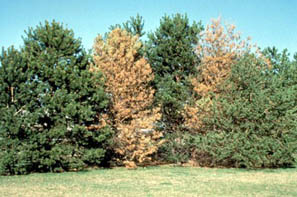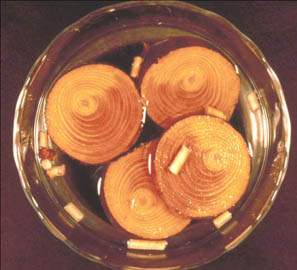Pine Wilt Obvious Now | |
|---|---|
| June 24, 2008 | |
|
Pines killed by pinewood nematode are obvious in many locations now, at least in Illinois. The disease is called pine wilt, and the pathogen is the pinewood nematode. The pathogen may infect most of the pine species we grow in Illinois, with the exception of white pines. White pines that suddenly discolor and die may have white pine decline or other root-related problems. They do not have pine wilt. The non-pine conifers are also exempt, so donít worry about this on spruce, true fir, or Douglas-fir. The most common hosts in Illinois are Scotch, Austrian, and mugo pines. Symptoms of pine wilt include the appearance of dull green needles on entire branches or over the entire tree. These soon turn brown, so you may miss the dull green stage. The process may take anywhere from a month to a year. Often, one or two dead trees appear in a line of healthy trees, as in this image.  This happens because the vector, the Sawyer beetle, feeds on a few trees and moves on to other sites. The nematode is spread in the feeding process. It is not spread by roots. In fact, it is not even present in the roots. It is not spread by contact between trees. Once a tree is infected with pinewood nematodes, it dies. Pine wilt does not allow any recovery periods. No chemicals are available that will kill the nematode and not the tree. The only management of the disease is to remove the infected tree from the site, and burn or bury it. Do this as soon as possible. Remove any dead pines, even if you are not certain of the presence of pinewood nematode. There is no point in giving a pine tree time to recover once it is brown. If you want to know whether pinewood nematodes are present in your tree, you can send a sample to the Plant Clinic. Consult this Web page for details on fees, shipping, etc.: http://plantclinic.cropsci.uiuc.edu/. Find a branch that is about 2 inches in diameter and has brown needles still attached. Cut a section of the branch about 10 to 12 inches long and mail it to the Plant Clinic for testing. We cut thin cross sections and soak them in water, as seen in the mage.  If present, the nematode pathogen swims out of the wood and into the water, where it can be identified with a microscope. For more on this disease, consult Report on Plant Disease (RPD), no.1104, available in Illinois Extension offices. The RPD is also available on the Web at http://www.ag.uiuc.edu/~vista/abstracts/a1104.html. | |
| Author: | Nancy Pataky |
